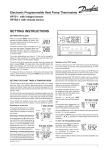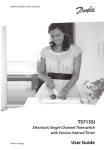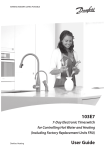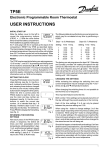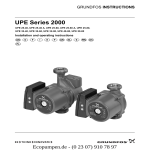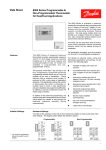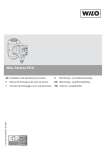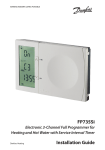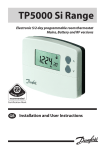Download Installation & Operating Instructions
Transcript
FH-RT Wireless Room Thermostat FH-BU Wireless Base Unit Installation & Operating Instructions Specification Power Base unit (230 V) Order Code: Primary voltage: Secondary voltage: Outputs 1-6: 088H012000 230 V a.c. 230 V a.c. 230 V a.c., 1 A max., relay controlled 8 A, 230 V a.c./50 Hz, relay controlled, convertible to volt-free outputs Outputs 7-8: Max. no. of thermostats: Max. no. of thermal actuators: Max. no. of thermal actuators per output: 8 (wireless) 20 Output 8 run-on time: Thermal actuator & pump exercise 10 min Once daily (approx. every 24 hours after connecting the power supply for the first time) Settings after power failure: Enclosure: Dimensions [mm] Ambient temperature: Humidity: User settings are retained IP20 310 x 110 x 55 0-50°C Less than 85% 1 Mode 2 3 4 5 6 7 8 OK 4 20 10 Thermostat Order Code: Temperature scale: Hysteresis: Scale accuracy: Night set-back: Frequency: Battery life: Battery type: Transmission range: Transmission interval: Ambient temperature: Humidity: 30 ❄ 088H012100 6-30°C +/- 2K +/- 0.5°C 2K around set point 4K at 20°C 433.70 MHz Min. 5 years 3.6 V lithium battery, 2100 mAh, size AA Up to 30 m (radius) 2-30 min 0-50°C Less than 90% System Schematic FH-RT ROOM THERMOSTATS OPTIONAL EXTERNAL ANTENNA FH-BU WIRING BOX Mains in THERMAL ACTUATORS MANIFOLD FLOOR LOOPS Zone1 Zone2 Zone3 Pump Interlock Boiler Interlock 1 These installation and operating instructions describe system function and technical data. The system is a complete floor heating control system for individual rooms in dwellings, offices, institutions, business premises, etc. The system is based on data transfer via radio, and is therefore quick and easy to install. The system was developed to meet requirements for comfort, heat economy, flexibility and user-friendly operation. Power 1 Mode 2 3 4 5 6 7 8 OK 20 10 30 ❄ Fig. 1. The system consists of a base unit, thermostat and, if necessary, an external aerial. 2.0 Operating principle The system consists of two unit types: base unit and thermostat. The base unit is connected to a 230 V supply and through eight outputs controls the thermal actuators that regulate the flow of hot water to the individual rooms. The system can also control circulation pump and boiler. The base unit is centrally located in the dwelling adjacent to the distribution manifold. 2.1 Base unit The base unit is the system interface. It consists of a control panel, radio receiver and alarm. If faults occur in the wireless data transfer, the base unit raises an alarm in order to make users aware of the fault. The alarm also informs the user when a thermostat requires a new battery. The receiver in the base unit continuously scans the radio signals it receives from installed thermostats. The base unit is usually installed about 1.5 metres above the floor in order to make the control panel easily accessible. Installation at this height also enhances the radio signal range of the system. 2.2 Thermostat Up to eight thermostats can be connected to the system. One thermostat can be used to control several thermal actuators. Thermostats are positioned at suitable locations in rooms where temperature control is required. Thermostats have a knob for setting the desired temperature and a switch for selecting one of three programs (day, timer control and night). Each thermostat contains a small battery that supplies current to an electronic temperature measuring circuit with associated radio transmitter. At suitable intervals the measured temperature is sent as a radio signal to the radio receiver in the base unit. If the temperature is changed the thermostat will transmit the new temperature after the suitable interval. For transmission test please see section on Transmission Testing, or Thermostat Test Mode. Thermostats have no external cable connections. Each thermostat has a unique identification (ID) number that is sent with every transmission. The base unit uses these ID numbers to distinguish the various thermostats. Thermostats must therefore be registered in the base unit before the unit is able to receive data from the thermostats. 2 During registration, thermostats transfer their ID numbers to the base unit. The use of ID numbers also prevents the base unit from reacting to signals received from neighbouring systems or other systems based on radio technology. Thermostats are battery powered and thus fully mobile, making it easy to re-configure the system if required. The system is CE marked and approved for use in all EU and former EFTA countries. The actual temperature is measured by the thermostat. When the actual temperature is lower than the set temperature, a command for heat is sent to the base unit. Temperature can be set between 6°C and 30°C. A function switch on the thermostat allows day, timer control or night to be selected. The day setting allows normal operation, the timer setting allows time-controlled night set-back to be used, and the night setting permanently lowers the temperature setting by 4°C. Thermostats are supplied with pre-installed batteries. Before being taken into use, thermostats are “dormant” and only begin measuring temperature and transmitting data on being registered in the base unit for the first time. The purpose of this dormant state is to minimise energy use during storage and to avoid unnecessary radio transmission. On being installed for the first time, thermostats automatically enter test mode so that transmission can be tested immediately. Battery life is guaranteed by the manufacturer to be at least 5 years. A complete system is illustrated above in Fig. 1. 2.3 Aerial Normally, the base unit uses a built-in aerial. The location of the base unit is therefore important for the range, which can be increased by equipping the base unit with an external aerial. An external aerial must be used if the base unit is located in a metal cabinet. 3.0 Installation instructions 4.0 Operating instructions The system should be installed by a competent person in the following sequence. 4.1 Thermal actuator installation 1. 3.1 Base unit Install the base unit first. Mount the base unit above the distribution manifold either direct on the wall or inside a wooden or metal distribution cabinet. Ensure that the base unit is mounted horizontally, that there is easy access to the control panel and thermal actuator connections, and that the base unit cover can be easily removed. Fix the base unit to the wall using two screws. The base unit must be connected to a 230 volt supply via a double pole switch socket outlet. If it is installed in a metal distribution cabinet, an aerial should be installed outside the cabinet in order to improve radio communication. 2. 3. 4. 5. 6. 7. 8. 9. Ensure that the power supply to the base unit is disconnected. Lift base unit cover after loosening front screws. Remove internal aerial. Remove blue thermal actuator terminals from printed circuit board. Connect thermal actuator cables. Reattach thermal actuator terminals in assigned order to printed circuit board. Position cables in strain-relief cable glands (see Fig 3). Replace internal aerial. Close base unit and tighten front screws 3.2 Thermostat installation Thermostats should be mounted on an internal wall at a height of 1.2-1.5 metres above the floor, using screws and fixings. Thermostats must not be placed on an external wall or near heat sources such as television and stereo sets, ovens or similar. Thermostats should not normally be placed where they can be affected by direct sunshine. In rooms that are very humid or damp, e.g. bathrooms, thermostats must be placed as far from moisture sources as possible. 3.3 Pre-installation Thermostats must be registered in the base unit before being placed in individual rooms. When registering thermostats, it is important that the room in which they are to be placed is written or marked on the rear of the thermostat. Thermostats can then be registered in turn. The channels to be used for individual rooms must therefore be decided in advance. Note: refer to section 4.3 for registration instructions Fig. 3. Push cable through cable gland. 4.2 Base unit installation Once the base unit has been mounted on the wall, all thermal actuators have been connected and any connections for pump and boiler control have been made, the thermostats can be registered. First, power up the base unit. The green ‘Power’ LED lights up. Ca. 1,5m Fig. 2a. Thermostat location Power 1 Mode 2 3 4 5 6 7 8 OK Fig. 4. Control panel. LED indicators 1-8 and ‘Power’ LED. Fig. 2b. Thermostat installation 3 4.3 Thermostat registration To get the FH-BU base into registration mode Press and hold “MODE” and “OK” buttons on base unit for 3 seconds, (all LED’s will flash) then release “MODE” and finally release “OK”. The system is now in registration mode. Only the “POWER” LED should be on (unless thermostats already have been assigned earlier- then the LED for these will be on) Fig. 6. De-registering thermostats Note: The system returns automatically to normal mode if no buttons are pressed during a 5-minute period. 4.5 Setting room temperature The temperature is set by turning the thermostat setting knob to the desired temperature. Fig. 5. Registration mode Thermostat registration process Using the point of a pencil press the thermostat transmission button. The LED for the first available channel (1-8) will start to flash. Select the channel to be assigned to the thermostat by pressing the “MODE” button numerous times until the LED for the desired channel flashes. Then press and hold “OK” for 3 seconds (the LED will flash and finally be on). The thermostat is now registered. Repeat the thermostat registration process for each thermostat. (Also if one thermostat should be assigned to several channels). After registering all thermostats, press and hold “MODE” for 3 seconds (all LED’s will flash), to return the system to normal mode. Note: The system returns automatically to normal mode if no buttons are pressed during a 5-minute period. 4.4 De-registering thermostats To get the FH-BU base unit into de-registration mode Press and hold “MODE” and “OK” buttons for 3 seconds, (all LED’s will flash) then release “OK”, and finally release “MODE”. The system is now in de-registration mode. (If only one thermostat is assigned the first assigned LED will start to flash). Press the thermostat transmission button. The LED for the first assigned channel will start to flash, (the rest will be on). Select the channel to be de-registered by pressing the “MODE” button numerous times until the LED for the desired channel flashes. Then press and hold “OK” for 3 seconds, (the LED will flash and finally go out). The channel is now de-registered. Repeat the thermostat deregistration process for each channel to be de-registered. After de-registering thermostats, press and hold the “MODE” button for 3 seconds (all LED’s flash) to return the system to normal mode. 4 4.6 Setting min./max. temperature Lift thermostat cover. Set min./max. temperatures using the red and blue limiters respectively. 4.7 Setting thermostat operating mode Switch position “sun” => normal => no night set-back. Switch position “moon” => night set-back => 4°C at 20°C. Switch position “clock” => timer-controlled set-back. If timer-controlled set-back is required, it must be programmed via the time clock/timer module (optional) fitted to the base unit. 5.0 Special functions 5.1 Master reset This function deletes all registered data and reinstalls factory settings. Switch off the power supply, press and hold “OK” and “MODE” simultaneously and keep pressing them while switching the power back on. LED indicators 1-8 then light up consecutively, and finally all eight indicators flash. Release “OK” and “MODE”. The system has now been reset to initial factory settings. 5.2 Transmission testing Transmission testing is used to test and identify all registered thermostats. Press and hold “OK” for 3 seconds (all LED indicators flash). All channels with assigned thermostats light up on the indicator panel. When a channel receives a signal from a thermostat, the corresponding indicator flashes twice and the indicators go off. If a signal is subsequently received from the same thermostat, the indicator for the corresponding channel flashes twice. The test is automatically terminated once all channels have received a signal from their assigned thermostat. If no signal is received from one or more thermostats, the corresponding LEDs on the indicator panel remain lit. When the required number of thermostats have been checked, press and hold “MODE” for 3 seconds to return the system to normal mode. Note: The system returns automatically to normal mode if no buttons are pressed during a 15-minute period. 5.3 Thermostat test mode This mode is used to test thermostat transmission. Using the point of a pencil or similar, press and hold the transmission button on the front of the thermostat for 3 seconds. This forces the thermostat to transmit a signal every 7 seconds for 5-6 minutes. can be de-activated by selecting the alarm “OFF” setting on the base unit (see Fig. 9). The alarm is reset when a button on the control panel is pressed or when the base unit receives a signal from the thermostat. 5.6 Thermal actuator & pump exercise This function prevents the manifold valve and circulating pump from sticking. It is activated once yearly. First, all assigned outputs are activated for 5 minutes, and the pump output is then activated for 5 minutes (only if pump output is installed). The function can be turned off by switching the EXERCISE switch to the OFF position. (See Fig. 10). 5.7 NO/NC thermal actuator settings Then check whether a signal from the thermostat is received by the base unit at 7 second intervals (the LED indicator for the assigned channel flashes on receiving a signal). The test can be terminated by again pressing the thermostat transmission button. Note: The system returns automatically to normal mode if no buttons are pressed during a 5-minute period. 5.4 Thermal actuator output testing Thermal actuator output testing is used to check the functioning of the base unit output relays. Press and hold the “MODE” button for 3 seconds (all LED indicators flash). The first indicator then begins flashing. Press “OK” to test the first channel. The LED indicator now flashes rapidly (on/off at half-second intervals) and a small click can be heard after about 5 seconds indicating that the output has been activated. Press “OK” again to de-activate the output. Press “MODE” to select the next output to be tested, and repeat the process described above. The test can be terminated by pressing and holding the “MODE” button for 3 seconds. Note: The system returns automatically to normal mode if no buttons are pressed during a 10-minute period. This function allows “Normally Closed’ (N/C) or “Normally Open” (N/ O) thermal actuators to be used. Type is selected on the ACTUATOR switch (see Fig. 10). 5.8 “Cooling” mode This mode allows thermostat signals to be inverted so that outputs are opened when the temperature is above the desired temperature and closed when below and is intended for use in cooling systems. 6.0 Boiler and pump interlock setting As standard, outputs 7 and 8 are set to control thermal actuators. However, output 7 can also be used to control a boiler via an ON/ OFF signal, and output 8 can be used to control a pump. To enable a boiler or pump to be controlled, the system must be configured as shown in Figs 8 and 9 respectively. Note: If outputs 7 and 8 are not used for thermal actuators, the following applies: LED indicators 7 and 8 light up when any other channel requires heat 5.5 Alarm function This function is initiated automatically in case of communication failure. If the base unit does not receive a signal from a registered thermostat for 2 hours, the corresponding LED indicator starts flashing. Simultaneously, the thermal actuator output begins a continuous cycle of 7 minutes’ activation and 14 minutes’ deactivation. If after a further 8 hours the base unit has still not received a signal from the thermostat, an acoustic alarm begins buzzing. The buzzer Fig. 8. Step 1. Remove right-hand jumper. Fig. 7. Switches Fig. 9. Step 2. Bend left-hand jumper as illustrated. 5 8.0 Drawing of Base Unit & Thermostat Connector for LEDs and buttons on lid Connector for timer module Special functions Fuse holders Aerial socket MMI MODULE ACTUATOR NC -> NO EXERCISE OFF -> ON BUZZER OFF -> ON TIMER COOL HEAT OUTPUT 7 MODE SELECTION Thermal actuator output 7 alternatively: boiler control output Thermal actuators outputs 1-6 Fig. 10. Base Unit OUTPUT 8 MODE SELECTION Power supply connectors Thermal actuator output 8 alternatively: pump control output DANSK VVS IMPORT LED indikator LED indicator Transmission button Transmissionsknap Min/ Max Min/max setting indstilling Indstilling af Thermostat natsænkning mode switch Fig. 11. Thermostat 9.0 Registration Record Output Channel 1 1 2 2 3 1 4 2 5 1 6 2 7/boiler (optional) 1 8/pump (optional) 2 Room Circuit Danfoss Randall can accept no responsibilty for possible errors in catalogues, brochures and other printed material. Danfoss Randall reserves the right to alter its products without notice. This also applies to products already on order provided that such alterations can be made without subsequent changes being necessary in specifications already agreed. Danfoss Randall Limited, Ampthill Road, Bedford, MK42 9ER Telephone: (01234) 364621 Fax: (01234) 219705 Email: danfossrandall@danfoss.com Website: www.danfoss-randall.co.uk 6 Part No: 90092 Iss: 04 05/05







